Paper Menu >>
Journal Menu >>
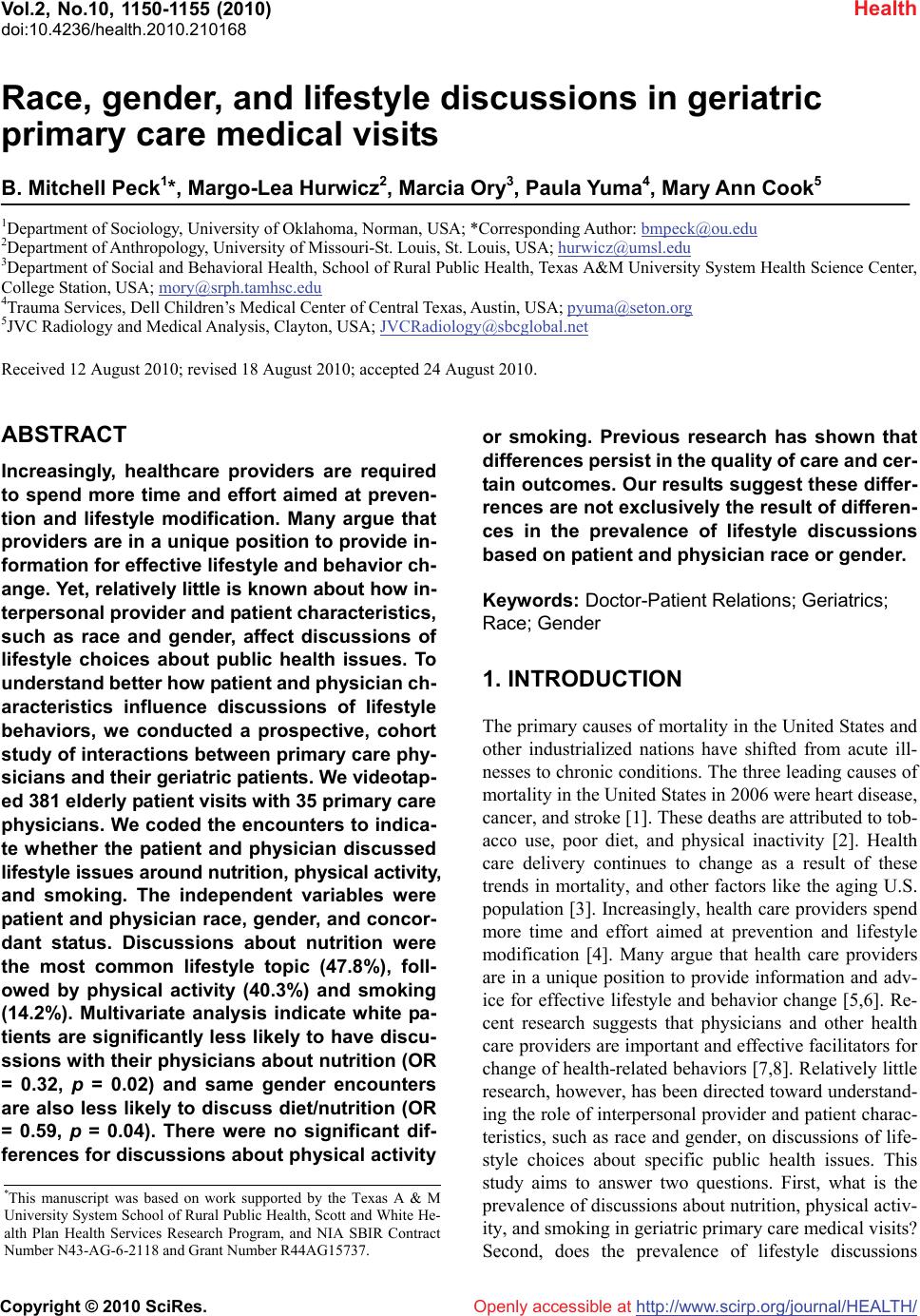 Vol.2, No.10, 1150-1155 (2010) Health doi:10.4236/health.2010.210168 Copyright © 2010 SciRes. Openly accessible at http://www.scirp.org/journal/HEALTH/ Race, gender, and lifestyle discussions in geriatric primary care medical visits B. Mitchell Peck1*, Margo-Lea Hurwicz2, Marcia Ory3, Paula Yuma4, Mary Ann Cook5 1Department of Sociology, University of Oklahoma, Norman, USA; *Corresponding Author: bmpeck@ou.edu 2Department of Anthropology, University of Missouri-St. Louis, St. Louis, USA; hurwicz@umsl.edu 3Department of Social and Behavioral Health, School of Rural Public Health, Texas A&M University System Health Science Center, College Station, USA; mory@srph.tamhsc.edu 4Trauma Services, Dell Children’s Medical Center of Central Texas, Austin, USA; pyuma@seton.org 5JVC Radiology and Medical Analysis, Clayton, USA; JVCRadiology@sbcglobal.net Received 12 August 2010; revised 18 August 2010; accepted 24 August 2010. ABSTRACT Increasingly, healthcare providers are required to spend more time and effort aimed at preven- tion and lifestyle modification. Many argue that providers are in a unique position to provide in- formation for effective lifestyle and behavior ch- ange. Yet, relatively little is known about how in- terpersonal provider and patient characteristics, such as race and gender, affect discussions of lifestyle choices about public health issues. To understand better how patient and physician ch- aracteristics influence discussions of lifestyle behaviors, we conducted a prospective, cohort study of interactions between primary care phy- sicians and their geriatric patients. We videotap- ed 381 elderly patient visits with 35 primary care physicians. We coded the encounters to indica- te whether the patient and physician discussed lifestyle issues around nutrition, physical activity, and smoking. The independent variables were patient and physician race, gender, and concor- dant status. Discussions about nutrition were the most common lifestyle topic (47.8%), foll- owed by physical activity (40.3%) and smoking (14.2%). Multivariate analysis indicate white pa- tients are significantly less likely to have discu- ssions with their physicians about nutrition (OR = 0.32, p = 0.02) and same gender encounters are also less likely to discuss diet/nutrition (OR = 0.59, p = 0.04). There were no significant dif- ferences for discussions about physical activity or smoking. Previous research has shown that differences persist in the quality of care and cer- tain outcomes. Our results suggest these differ- rences are not exclusively the result of differen- ces in the prevalence of lifestyle discussions based on patient and physician race or gender. Keywords: Doctor-Patient Relations; Geriatrics; Race; Gender 1. INTRODUCTION The primary causes of mortality in the United States and other industrialized nations have shifted from acute ill- nesses to chronic conditions. The three leading causes of mortality in the United States in 2006 were heart disease, cancer, and stroke [1]. These deaths are attributed to tob- acco use, poor diet, and physical inactivity [2]. Health care delivery continues to change as a result of these trends in mortality, and other factors like the aging U.S. population [3]. Increasingly, health care providers spend more time and effort aimed at prevention and lifestyle modification [4]. Many argue that health care providers are in a unique position to provide information and adv- ice for effective lifestyle and behavior change [5,6]. Re- cent research suggests that physicians and other health care providers are important and effective facilitators for change of health-related behaviors [7,8]. Relatively little research, however, has been directed toward understand- ing the role of interpersonal provider and patient charac- teristics, such as race and gender, on discussions of life- style choices about specific public health issues. This study aims to answer two questions. First, what is the prevalence of discussions about nutrition, physical activ- ity, and smoking in geriatric primary care medical visits? Second, does the prevalence of lifestyle discussions *This manuscript was based on work supported by the Texas A & M University System School of Rural Public Health, Scott and White He- alth Plan Health Services Research Program, and NIA SBIR Contract N umber N43-AG-6-2118 and Grant Number R44AG15737. 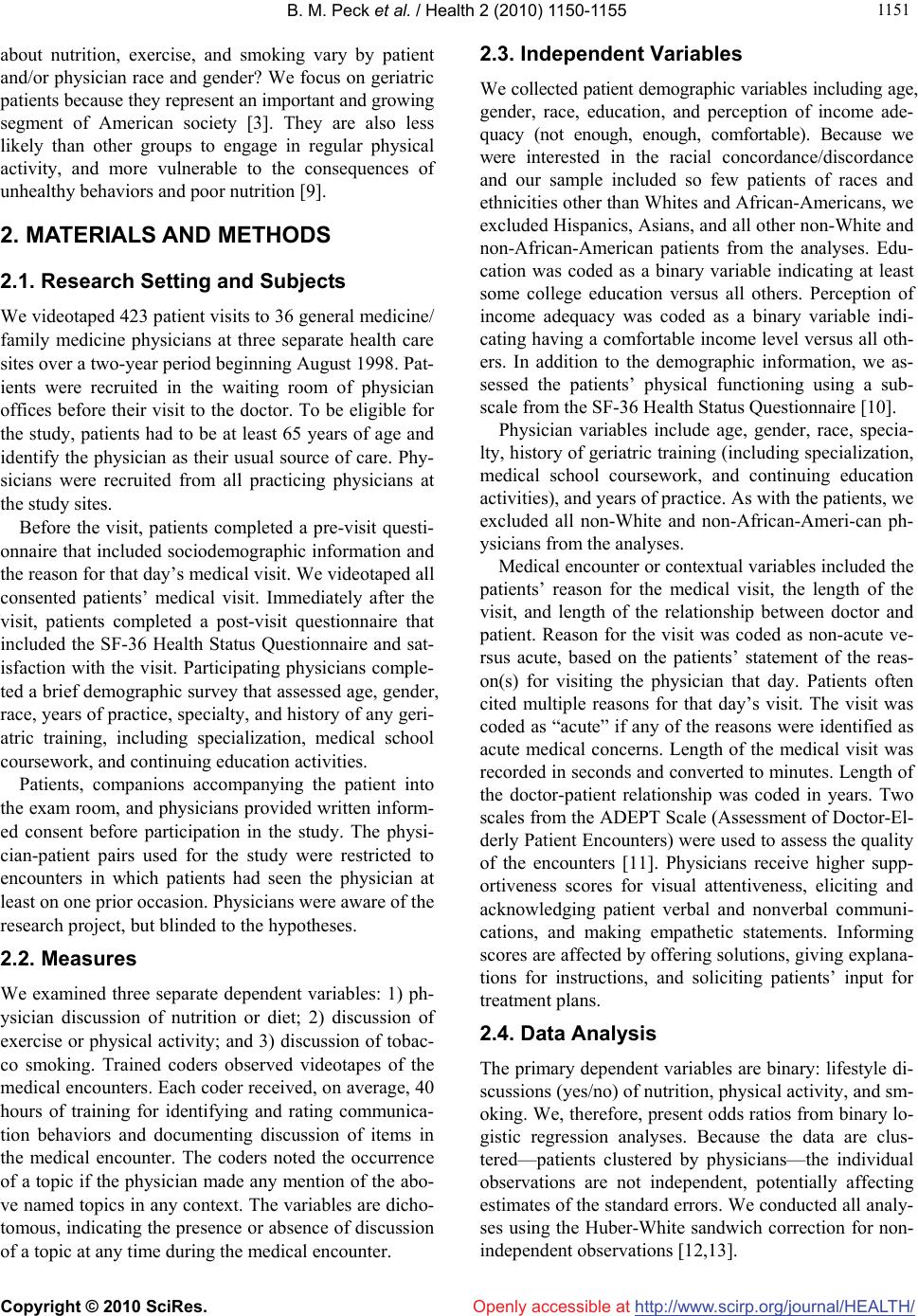 B. M. Peck et al. / Health 2 (2010) 1150-1155 Copyright © 2010 SciRes. Openly accessible at http://www.scirp.org/journal/HEALTH/ 115 1151 about nutrition, exercise, and smoking vary by patient and/or physician race and gender? We focus on geriatric patients because they represent an important and growing segment of American society [3]. They are also less likely than other groups to engage in regular physical activity, and more vulnerable to the consequences of unhealthy behaviors and poor nutrition [9]. 2. MATERIALS AND METHODS 2.1. Research Setting and Subjects We videotaped 423 patient visits to 36 general medicine/ family medicine physicians at three separate health care sites over a two-year period beginning August 1998. Pat- ients were recruited in the waiting room of physician offices before their visit to the doctor. To be eligible for the study, patients had to be at least 65 years of age and identify the physician as their usual source of care. Phy- sicians were recruited from all practicing physicians at the study sites. Before the visit, patients completed a pre-visit questi- onnaire that included sociodemographic information and the reason for that day’s medical visit. We videotaped all consented patients’ medical visit. Immediately after the visit, patients completed a post-visit questionnaire that included the SF-36 Health Status Questionnaire and sat- isfaction with the visit. Participating physicians comple- ted a brief demographic survey that assessed age, gender, race, years of practice, specialty, and history of any geri- atric training, including specialization, medical school coursework, and continuing education activities. Patients, companions accompanying the patient into the exam room, and physicians provided written inform- ed consent before participation in the study. The physi- cian-patient pairs used for the study were restricted to encounters in which patients had seen the physician at least on one prior occasion. Physicians were aware of the research project, but blinded to the hypotheses. 2.2. Measures We examined three separate dependent variables: 1) ph- ysician discussion of nutrition or diet; 2) discussion of exercise or physical activity; and 3) discussion of tobac- co smoking. Trained coders observed videotapes of the medical encounters. Each coder received, on average, 40 hours of training for identifying and rating communica- tion behaviors and documenting discussion of items in the medical encounter. The coders noted the occurrence of a topic if the physician made any mention of the abo- ve named topics in any context. The variables are dicho- tomous, indicating the presence or absence of discussion of a topic at any time during the medical encounter. 2.3. Independent Variables We collected patient demographic variables including age, gender, race, education, and perception of income ade- quacy (not enough, enough, comfortable). Because we were interested in the racial concordance/discordance and our sample included so few patients of races and ethnicities other than Whites and African-Americans, we excluded Hispanics, Asians, and all other non-White and non-African-American patients from the analyses. Edu- cation was coded as a binary variable indicating at least some college education versus all others. Perception of income adequacy was coded as a binary variable indi- cating having a comfortable income level versus all oth- ers. In addition to the demographic information, we as- sessed the patients’ physical functioning using a sub- scale from the SF-36 Health Status Questionnaire [10]. Physician variables include age, gender, race, specia- lty, history of geriatric training (including specialization, medical school coursework, and continuing education activities), and years of practice. As with the patients, we excluded all non-White and non-African-Ameri-can ph- ysicians from the analyses. Medical encounter or contextual variables included the patients’ reason for the medical visit, the length of the visit, and length of the relationship between doctor and patient. Reason for the visit was coded as non-acute ve- rsus acute, based on the patients’ statement of the reas- on(s) for visiting the physician that day. Patients often cited multiple reasons for that day’s visit. The visit was coded as “acute” if any of the reasons were identified as acute medical concerns. Length of the medical visit was recorded in seconds and converted to minutes. Length of the doctor-patient relationship was coded in years. Two scales from the ADEPT Scale (Assessment of Doctor-El- derly Patient Encounters) were used to assess the quality of the encounters [11]. Physicians receive higher supp- ortiveness scores for visual attentiveness, eliciting and acknowledging patient verbal and nonverbal communi- cations, and making empathetic statements. Informing scores are affected by offering solutions, giving explana- tions for instructions, and soliciting patients’ input for treatment plans. 2.4. Data Analysis The primary dependent variables are binary: lifestyle di- scussions (yes/no) of nutrition, physical activity, and sm- oking. We, therefore, present odds ratios from binary lo- gistic regression analyses. Because the data are clus- tered—patients clustered by physicians—the individual observations are not independent, potentially affecting estimates of the standard errors. We conducted all analy- ses using the Huber-White sandwich correction for non- independent observations [12,13]. 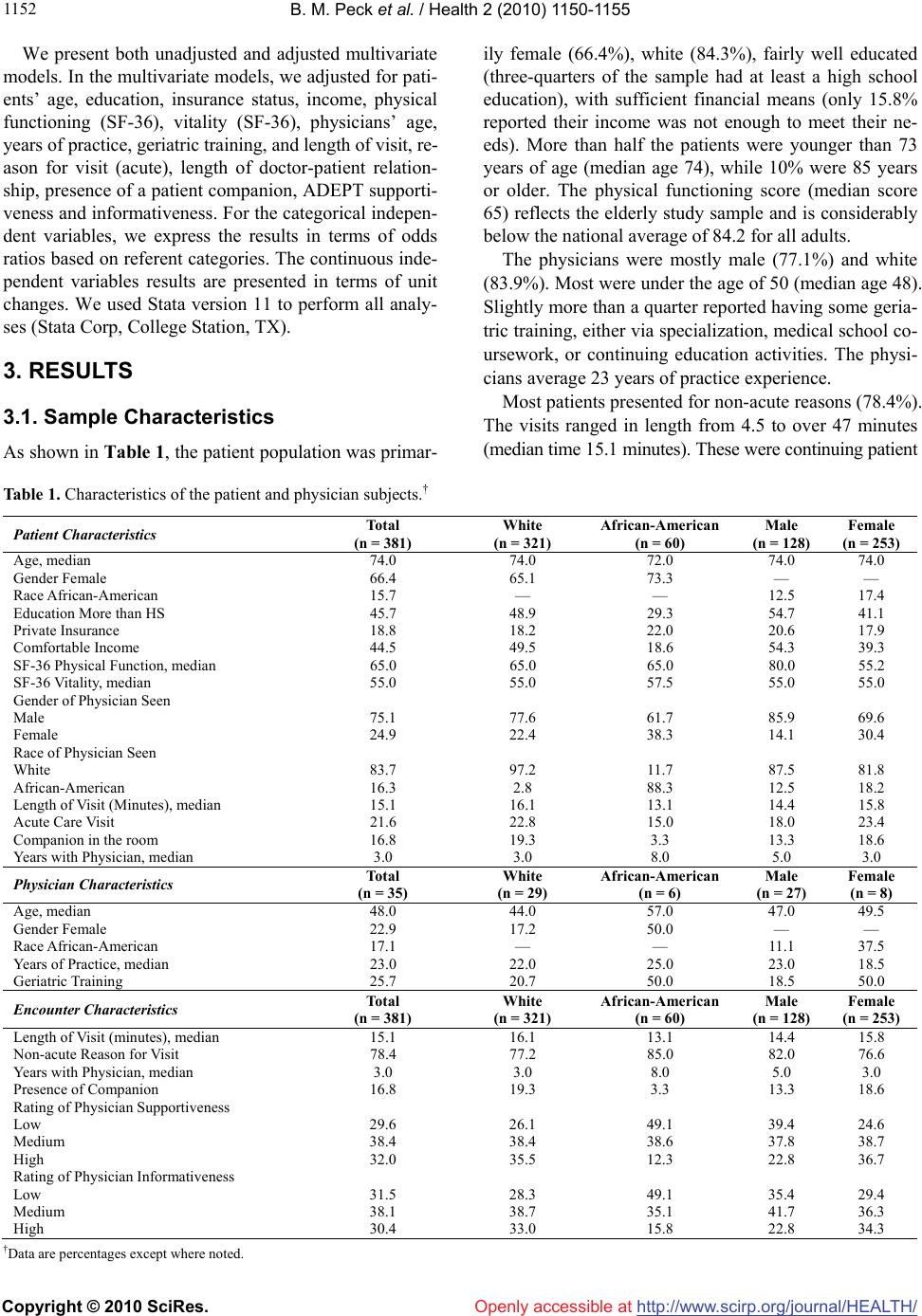 B. M. Peck et al. / Health 2 (2010) 1150-1155 Copyright © 2010 SciRes. Openly accessible at http://www.scirp.org/journal/HEALTH/ 1152 We present both unadjusted and adjusted multivariate models. In the multivariate models, we adjusted for pati- ents’ age, education, insurance status, income, physical functioning (SF-36), vitality (SF-36), physicians’ age, years of practice, geriatric training, and length of visit, re- ason for visit (acute), length of doctor-patient relation- ship, presence of a patient companion, ADEPT supporti- veness and informativeness. For the categorical indepen- dent variables, we express the results in terms of odds ratios based on referent categories. The continuous inde- pendent variables results are presented in terms of unit changes. We used Stata version 11 to perform all analy- ses (Stata Corp, College Station, TX). 3. RESULTS 3.1. Sample Characteristics As shown in Table 1, the patient population was primar- ily female (66.4%), white (84.3%), fairly well educated (three-quarters of the sample had at least a high school education), with sufficient financial means (only 15.8% reported their income was not enough to meet their ne- eds). More than half the patients were younger than 73 years of age (median age 74), while 10% were 85 years or older. The physical functioning score (median score 65) reflects the elderly study sample and is considerably below the national average of 84.2 for all adults. The physicians were mostly male (77.1%) and white (83.9%). Most were under the age of 50 (median age 48). Slightly more than a quarter reported having some geria- tric training, either via specialization, medical school co- ursework, or continuing education activities. The physi- cians average 23 years of practice experience. Most patients presented for non-acute reasons (78.4%). The visits ranged in length from 4.5 to over 47 minutes (median time 15.1 minutes). These were continuing patient Table 1. Characteristics of the patient and physician subjects.† Patient Characteristics Total (n = 381) White (n = 321) African-American (n = 60) Male (n = 128) Female (n = 253) Age, median 74.0 74.0 72.0 74.0 74.0 Gender Female 66.4 65.1 73.3 — — Race African-American 15.7 — — 12.5 17.4 Education More than HS 45.7 48.9 29.3 54.7 41.1 Private Insurance 18.8 18.2 22.0 20.6 17.9 Comfortable Income 44.5 49.5 18.6 54.3 39.3 SF-36 Physical Function, median 65.0 65.0 65.0 80.0 55.2 SF-36 Vitality, median 55.0 55.0 57.5 55.0 55.0 Gender of Physician Seen Male 75.1 77.6 61.7 85.9 69.6 Female 24.9 22.4 38.3 14.1 30.4 Race of Physician Seen White 83.7 97.2 11.7 87.5 81.8 African-American 16.3 2.8 88.3 12.5 18.2 Length of Visit (Minutes), median 15.1 16.1 13.1 14.4 15.8 Acute Care Visit 21.6 22.8 15.0 18.0 23.4 Companion in the room 16.8 19.3 3.3 13.3 18.6 Years with Physician, median 3.0 3.0 8.0 5.0 3.0 Physician Characteristics Total (n = 35) White (n = 29) African-American (n = 6) Male (n = 27) Female (n = 8) Age, median 48.0 44.0 57.0 47.0 49.5 Gender Female 22.9 17.2 50.0 — — Race African-American 17.1 — — 11.1 37.5 Years of Practice, median 23.0 22.0 25.0 23.0 18.5 Geriatric Training 25.7 20.7 50.0 18.5 50.0 Encounter Characteristics Total (n = 381) White (n = 321) African-American (n = 60) Male (n = 128) Female (n = 253) Length of Visit (minutes), median 15.1 16.1 13.1 14.4 15.8 Non-acute Reason for Visit 78.4 77.2 85.0 82.0 76.6 Years with Physician, median 3.0 3.0 8.0 5.0 3.0 Presence of Companion 16.8 19.3 3.3 13.3 18.6 Rating of Physician Supportiveness Low 29.6 26.1 49.1 39.4 24.6 Medium 38.4 38.4 38.6 37.8 38.7 High 32.0 35.5 12.3 22.8 36.7 Rating of Physician Informativeness Low 31.5 28.3 49.1 35.4 29.4 Medium 38.1 38.7 35.1 41.7 36.3 High 30.4 33.0 15.8 22.8 34.3 †Data are percentages except where noted. 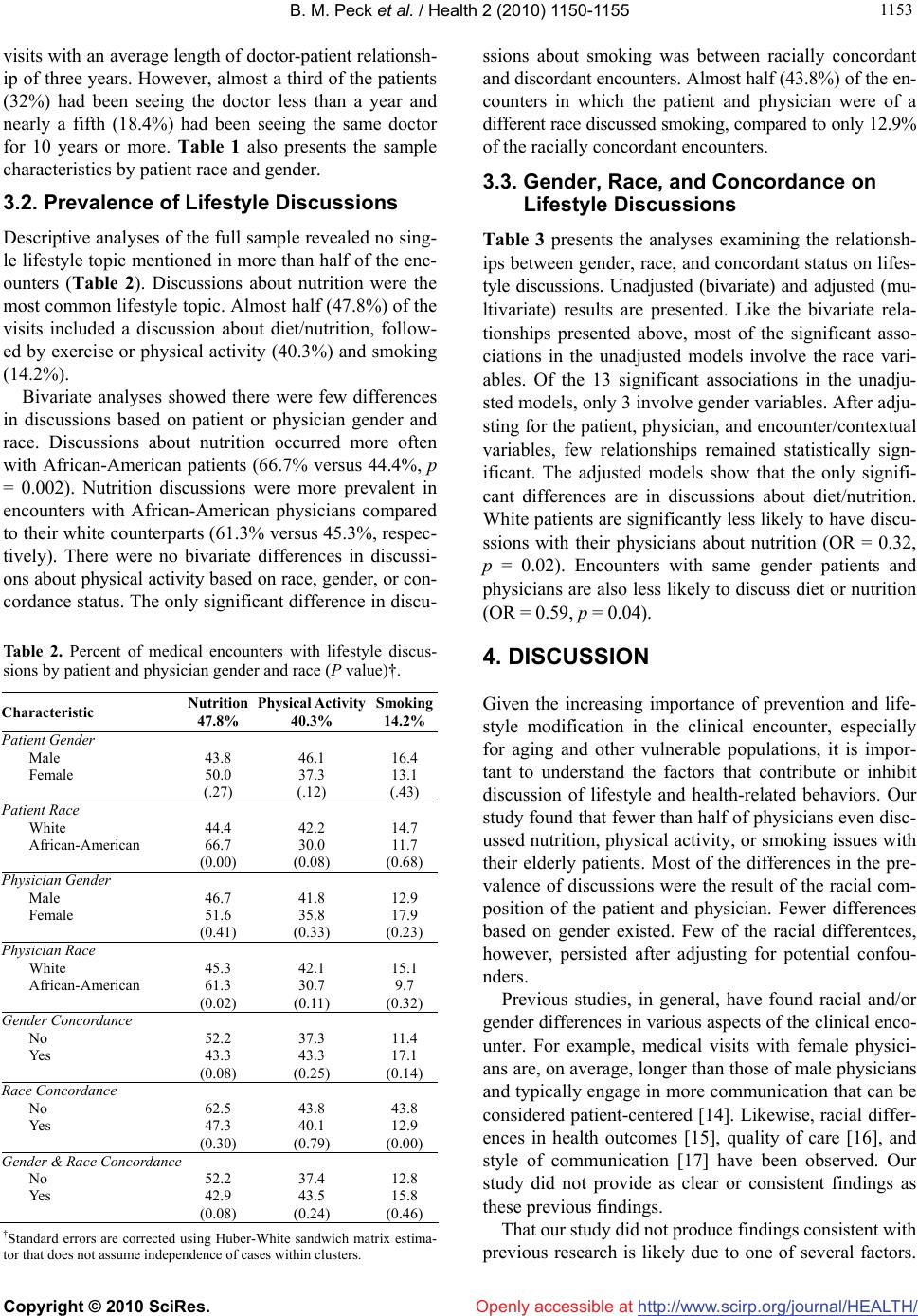 B. M. Peck et al. / Health 2 (2010) 1150-1155 Copyright © 2010 SciRes. Openly accessible at http://www.scirp.org/journal/HEALTH/ 115 1153 visits with an average length of doctor-patient relationsh- ip of three years. However, almost a third of the patients (32%) had been seeing the doctor less than a year and nearly a fifth (18.4%) had been seeing the same doctor for 10 years or more. Table 1 also presents the sample characteristics by patient race and gender. 3.2. Prevalence of Lifestyle Discussions Descriptive analyses of the full sample revealed no sing- le lifestyle topic mentioned in more than half of the enc- ounters (Table 2). Discussions about nutrition were the most common lifestyle topic. Almost half (47.8%) of the visits included a discussion about diet/nutrition, follow- ed by exercise or physical activity (40.3%) and smoking (14.2%). Bivariate analyses showed there were few differences in discussions based on patient or physician gender and race. Discussions about nutrition occurred more often with African-American patients (66.7% versus 44.4%, p = 0.002). Nutrition discussions were more prevalent in encounters with African-American physicians compared to their white counterparts (61.3% versus 45.3%, respec- tively). There were no bivariate differences in discussi- ons about physical activity based on race, gender, or con- cordance status. The only significant difference in discu- Table 2. Percent of medical encounters with lifestyle discus- sions by patient and physician gender and race (P value)†. Characteristic Nutrition 47.8% Physical Activity 40.3% Smoking 14.2% Patient Gender Male 43.8 46.1 16.4 Female 50.0 37.3 13.1 (.27) (.12) (.43) Patient Race White 44.4 42.2 14.7 African-American 66.7 30.0 11.7 (0.00) (0.08) (0.68) Physician Gender Male 46.7 41.8 12.9 Female 51.6 35.8 17.9 (0.41) (0.33) (0.23) Physician Race White 45.3 42.1 15.1 African-American 61.3 30.7 9.7 (0.02) (0.11) (0.32) Gender Concordance No 52.2 37.3 11.4 Yes 43.3 43.3 17.1 (0.08) (0.25) (0.14) Race Concordance No 62.5 43.8 43.8 Yes 47.3 40.1 12.9 (0.30) (0.79) (0.00) Gender & Race Concordance No 52.2 37.4 12.8 Yes 42.9 43.5 15.8 (0.08) (0.24) (0.46) †Standard errors are corrected using Huber-White sandwich matrix estima- tor that does not assume independence of cases within clusters. ssions about smoking was between racially concordant and discordant encounters. Almost half (43.8%) of the en- counters in which the patient and physician were of a different race discussed smoking, compared to only 12.9% of the racially concordant encounters. 3.3. Gender, Race, and Concordance on Lifestyle Discussions Table 3 presents the analyses examining the relationsh- ips between gender, race, and concordant status on lifes- tyle discussions. Unadjusted (bivariate) and adjusted (mu- ltivariate) results are presented. Like the bivariate rela- tionships presented above, most of the significant asso- ciations in the unadjusted models involve the race vari- ables. Of the 13 significant associations in the unadju- sted models, only 3 involve gender variables. After adju- sting for the patient, physician, and encounter/contextual variables, few relationships remained statistically sign- ificant. The adjusted models show that the only signifi- cant differences are in discussions about diet/nutrition. White patients are significantly less likely to have discu- ssions with their physicians about nutrition (OR = 0.32, p = 0.02). Encounters with same gender patients and physicians are also less likely to discuss diet or nutrition (OR = 0.59, p = 0.04). 4. DISCUSSION Given the increasing importance of prevention and life- style modification in the clinical encounter, especially for aging and other vulnerable populations, it is impor- tant to understand the factors that contribute or inhibit discussion of lifestyle and health-related behaviors. Our study found that fewer than half of physicians even disc- ussed nutrition, physical activity, or smoking issues with their elderly patients. Most of the differences in the pre- valence of discussions were the result of the racial com- position of the patient and physician. Fewer differences based on gender existed. Few of the racial differentces, however, persisted after adjusting for potential confou- nders. Previous studies, in general, have found racial and/or gender differences in various aspects of the clinical enco- unter. For example, medical visits with female physici- ans are, on average, longer than those of male physicians and typically engage in more communication that can be considered patient-centered [14]. Likewise, racial differ- ences in health outcomes [15], quality of care [16], and style of communication [17] have been observed. Our study did not provide as clear or consistent findings as these previous findings. That our study did not produce findings consistent with previous research is likely due to one of several factors. 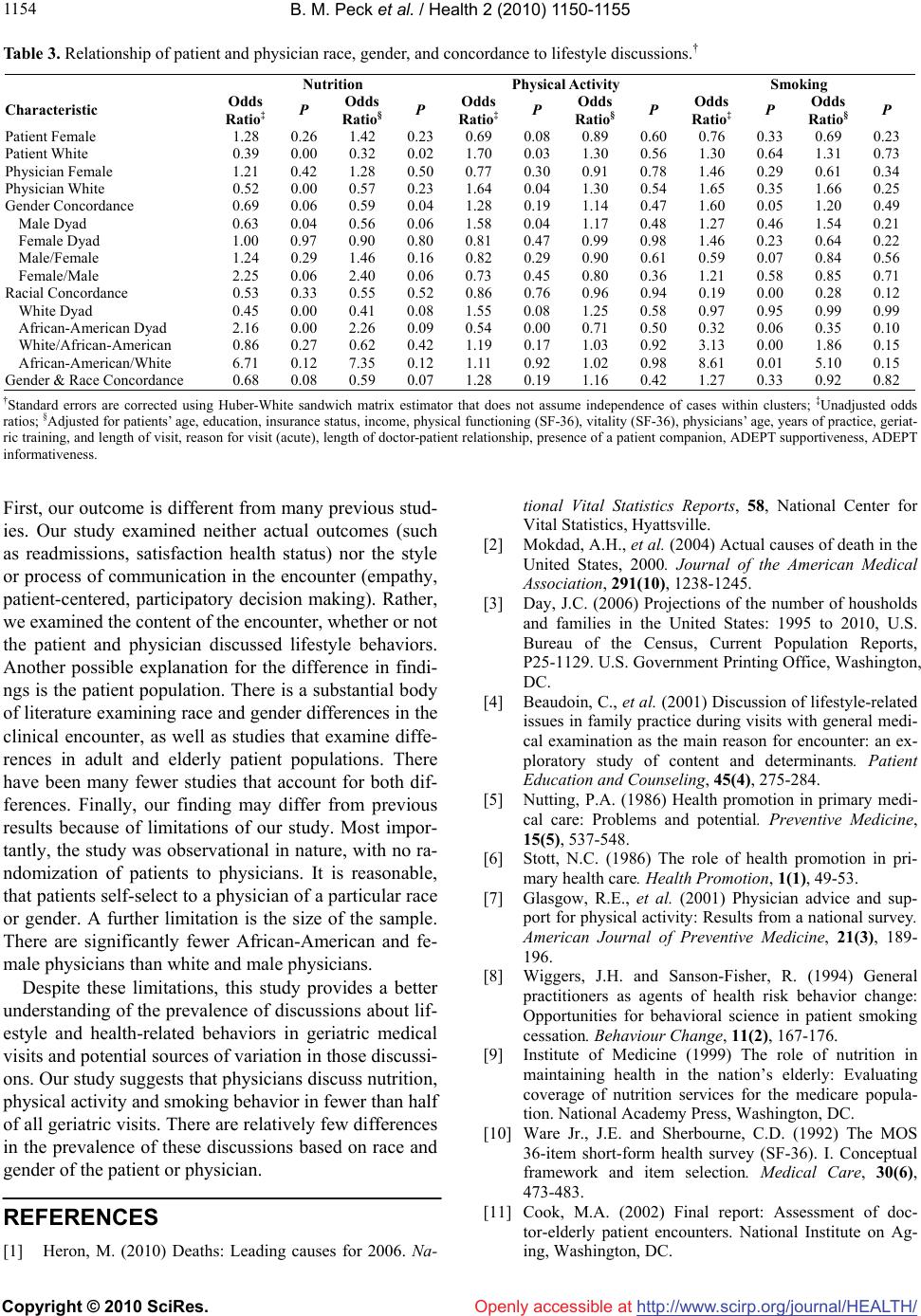 B. M. Peck et al. / Health 2 (2010) 1150-1155 Copyright © 2010 SciRes. Openly accessible at http://www.scirp.org/journal/HEALTH/ 1154 Table 3. Relationship of patient and physician race, gender, and concordance to lifestyle discussions.† Nutrition Physical Activity Smoking Characteristic Odds Ratio‡ P Odds Ratio§P Odds Ratio‡P Odds Ratio§P Odds Ratio‡ P Odds Ratio§P Patient Female 1.28 0.26 1.42 0.23 0.69 0.08 0.89 0.60 0.76 0.33 0.69 0.23 Patient White 0.39 0.00 0.32 0.02 1.70 0.03 1.30 0.56 1.30 0.64 1.31 0.73 Physician Female 1.21 0.42 1.28 0.50 0.77 0.30 0.91 0.78 1.46 0.29 0.61 0.34 Physician White 0.52 0.00 0.57 0.23 1.64 0.04 1.30 0.54 1.65 0.35 1.66 0.25 Gender Concordance 0.69 0.06 0.59 0.04 1.28 0.19 1.14 0.47 1.60 0.05 1.20 0.49 Male Dyad 0.63 0.04 0.56 0.06 1.58 0.04 1.17 0.48 1.27 0.46 1.54 0.21 Female Dyad 1.00 0.97 0.90 0.80 0.81 0.47 0.99 0.98 1.46 0.23 0.64 0.22 Male/Female 1.24 0.29 1.46 0.16 0.82 0.29 0.90 0.61 0.59 0.07 0.84 0.56 Female/Male 2.25 0.06 2.40 0.06 0.73 0.45 0.80 0.36 1.21 0.58 0.85 0.71 Racial Concordance 0.53 0.33 0.55 0.52 0.86 0.76 0.96 0.94 0.19 0.00 0.28 0.12 White Dyad 0.45 0.00 0.41 0.08 1.55 0.08 1.25 0.58 0.97 0.95 0.99 0.99 African-American Dyad 2.16 0.00 2.26 0.09 0.54 0.00 0.71 0.50 0.32 0.06 0.35 0.10 White/African-American 0.86 0.27 0.62 0.42 1.19 0.17 1.03 0.92 3.13 0.00 1.86 0.15 African-American/White 6.71 0.12 7.35 0.12 1.11 0.92 1.02 0.98 8.61 0.01 5.10 0.15 Gender & Race Concordance 0.68 0.08 0.59 0.07 1.28 0.19 1.16 0.42 1.27 0.33 0.92 0.82 †Standard errors are corrected using Huber-White sandwich matrix estimator that does not assume independence of cases within clusters; ‡Unadjusted odds ratios; §Adjusted for patients’ age, education, insurance status, income, physical functioning (SF-36), vitality (SF-36), physicians’ age, years of practice, geriat- ric training, and length of visit, reason for visit (acute), length of doctor-patient relationship, presence of a patient companion, ADEPT supportiveness, ADEPT informativeness. First, our outcome is different from many previous stud- ies. Our study examined neither actual outcomes (such as readmissions, satisfaction health status) nor the style or process of communication in the encounter (empathy, patient-centered, participatory decision making). Rather, we examined the content of the encounter, whether or not the patient and physician discussed lifestyle behaviors. Another possible explanation for the difference in findi- ngs is the patient population. There is a substantial body of literature examining race and gender differences in the clinical encounter, as well as studies that examine diffe- rences in adult and elderly patient populations. There have been many fewer studies that account for both dif- ferences. Finally, our finding may differ from previous results because of limitations of our study. Most impor- tantly, the study was observational in nature, with no ra- ndomization of patients to physicians. It is reasonable, that patients self-select to a physician of a particular race or gender. A further limitation is the size of the sample. There are significantly fewer African-American and fe- male physicians than white and male physicians. Despite these limitations, this study provides a better understanding of the prevalence of discussions about lif- estyle and health-related behaviors in geriatric medical visits and potential sources of variation in those discussi- ons. Our study suggests that physicians discuss nutrition, physical activity and smoking behavior in fewer than half of all geriatric visits. There are relatively few differences in the prevalence of these discussions based on race and gender of the patient or physician. REFERENCES [1] Heron, M. (2010) Deaths: Leading causes for 2006. Na- tional Vital Statistics Reports, 58, National Center for Vital Statistics, Hyattsville. [2] Mokdad, A.H., et al. (2004) Actual causes of death in the United States, 2000. Journal of the American Medical Association, 291(10), 1238-1245. [3] Day, J.C. (2006) Projections of the number of housholds and families in the United States: 1995 to 2010, U.S. Bureau of the Census, Current Population Reports, P25-1129. U.S. Government Printing Office, Washington, DC. [4] Beaudoin, C., et al. (2001) Discussion of lifestyle-related issues in family practice during visits with general medi- cal examination as the main reason for encounter: an ex- ploratory study of content and determinants. Patient Education and Counseling, 45(4), 275-284. [5] Nutting, P.A. (1986) Health promotion in primary medi- cal care: Problems and potential. Preventive Medicine, 15(5), 537-548. [6] Stott, N.C. (1986) The role of health promotion in pri- mary health care. Health Promotion, 1(1), 49-53. [7] Glasgow, R.E., et al. (2001) Physician advice and sup- port for physical activity: Results from a national survey. American Journal of Preventive Medicine, 21(3), 189- 196. [8] Wiggers, J.H. and Sanson-Fisher, R. (1994) General practitioners as agents of health risk behavior change: Opportunities for behavioral science in patient smoking cessation. Behaviour Change, 11(2), 167-176. [9] Institute of Medicine (1999) The role of nutrition in maintaining health in the nation’s elderly: Evaluating coverage of nutrition services for the medicare popula- tion. National Academy Press, Washington, DC. [10] Ware Jr., J.E. and Sherbourne, C.D. (1992) The MOS 36-item short-form health survey (SF-36). I. Conceptual framework and item selection. Medical Care, 30(6), 473-483. [11] Cook, M.A. (2002) Final report: Assessment of doc- tor-elderly patient encounters. National Institute on Ag- ing, Washington, DC.  B. M. Peck et al. / Health 2 (2010) 1150-1155 Copyright © 2010 SciRes. Openly accessible at http://www.scirp.org/journal/HEALTH/ 115 1155 [12] Huber, P.J. (1967) The behavior of maximum likelihood estimates under nonstandard conditions. Proceedings of the 5th Berkeley Symposium on Mathematical Statistics and Probability: Statistics, 1(1), 221-233. [13] White, H. (1980) A heteroskedasticity-consistent covari- ance matrix estimator and a direct test for heteroskedas- ticity. Econometrica, 48(4), 817-830. [14] Roter, D.L. and Hall, J.A. (2004) Physician gender and patient-centered communication: a critical review of em- pirical research. Annual Review of Public Health, 25(1), 497-519. [15] Epstein, A.M., et al. (2003) Race and gender disparities in rates of cardiac revascularization: do they reflect ap- propriate use of procedures or problems in quality of care? Medical Care, 41(11), 1240-1255. [16] Institute of Medicine (2002) Unequal treatment: con- fronting racial and ethnic disparities in health care. Na- tional Academy Press, Washington, DC. [17] Cooper-Patrick, L., et al. (1999) Race, gender, and part- nership in the patient-physician relationship. Journal of the American Medical Association, 282(6), 583-589. |

